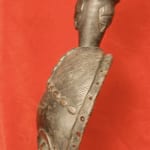Baule Wooden Facemask, 20th Century CE
Wood
PF.8021 (LSO)
Further images
This remarkable facemask was made by the Baule, the most powerful tribe in the Ivory Coast and among Africa’s greatest artistic creators. It is highly unusual, and is not a...
This remarkable facemask was made by the Baule, the most powerful tribe in the Ivory Coast and among Africa’s greatest artistic creators. It is highly unusual, and is not a variant that commonly appears on the market. It appears to be a female face, with a pointed chin and a domed forehead, with very emphatically-marked nose/brows, a round mouth and painted eyelids that lend the mask a somewhat surprised expression. The top one quarter of the mask is rendered as a laterally-oriented crested coiffure, divided in two by beading in the midline and also along the inferior border of the hair. The apex of the head bears a tall handle-like protuberance bearing small maskettes and further abstract decoration. Patination is glossy though age is uncertain.
The Baule live across the Ivory Coast area, and have an economy based primarily on sedentary agriculturism. They have thus been able to build up a considerable political and economic stronghold, which has in turn given rise to a strong ritual and artistic heritage. Their own creation story relates to an ancient migration, in which the queen was forced to sacrifice her son in order to ford a mighty river. So upset was she that all she could say was “baouli” (the child is dead), thus giving rise to the tribe’s name.
Blolo bian (male) and Blolo bla (female) spirit spouses are perhaps the Baule’s greatest artistic and psycho-social achievement, but they are also renowned for sculptures representing bush spirits (Asie usu) (mischievous and potentially malevolent inhabitants of the “bush” or dark country beyond the boundary of the village). They are also known for their masks, which have a range of diplomatic and ritual functions. The function of this mask would seem to be diplomatic; single-headed variants are worn to receive important dignitaries, and were used for displays to entertain them.
Like most other human societies, the Baule are prey to conspicuous consumption, which is a central key to asserting ones status in the village, and thus ones power and influence. While their carving is among the most refined and restrained in Africa, therefore, artists vie to produce more impressive and beautiful carvings which are often decorated or adorned by their proud owners. This is a charming piece of African art.
The Baule live across the Ivory Coast area, and have an economy based primarily on sedentary agriculturism. They have thus been able to build up a considerable political and economic stronghold, which has in turn given rise to a strong ritual and artistic heritage. Their own creation story relates to an ancient migration, in which the queen was forced to sacrifice her son in order to ford a mighty river. So upset was she that all she could say was “baouli” (the child is dead), thus giving rise to the tribe’s name.
Blolo bian (male) and Blolo bla (female) spirit spouses are perhaps the Baule’s greatest artistic and psycho-social achievement, but they are also renowned for sculptures representing bush spirits (Asie usu) (mischievous and potentially malevolent inhabitants of the “bush” or dark country beyond the boundary of the village). They are also known for their masks, which have a range of diplomatic and ritual functions. The function of this mask would seem to be diplomatic; single-headed variants are worn to receive important dignitaries, and were used for displays to entertain them.
Like most other human societies, the Baule are prey to conspicuous consumption, which is a central key to asserting ones status in the village, and thus ones power and influence. While their carving is among the most refined and restrained in Africa, therefore, artists vie to produce more impressive and beautiful carvings which are often decorated or adorned by their proud owners. This is a charming piece of African art.





